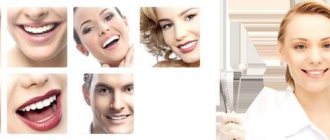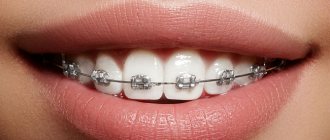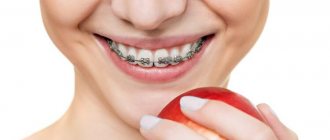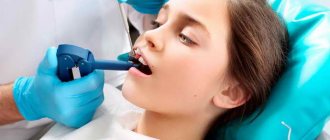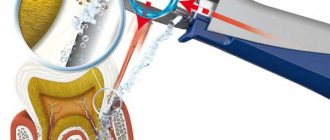Problems with malocclusion can occur at any age. If you do not pay due attention to this problem in time, teeth may begin to decay and fall out. To prevent such developments, dentists recommend using special braces to restore a beautiful smile and prevent the development of various diseases associated with malocclusion. Have you ever wondered at what age can an adult get braces? You will find the answer in our article.
Types of orthodontic systems
At what age can a child get braces? This question can be heard quite often in the dentist's office. The answer will depend on the type of orthodontic system you plan to use. Some of them are designed to correct teeth and are suitable even for an old person, others are designed to eliminate serious malocclusions in childhood and adolescence. Therefore, the choice of a particular system is based not only on the patient’s personal preferences, but also on the individual characteristics of the body.
- Metal system. This type of braces is attached to the outer surface of the teeth and is quite noticeable during conversations. The period of adaptation of the body to the system is quite short - 5-7 days. The course of therapy usually lasts from 1 to 3 years. A fairly reliable option that guarantees almost one hundred percent results.
- Ceramic system. The undoubted advantage of these braces is that they are practically invisible (although the fastening is carried out on the outside of the teeth). A similar effect is achieved through the use of ceramics of various shades. The adaptation period to such a system ranges from 1 to 2 weeks. Therapy usually ends after 2-4 years. As for reliability, it is quite high, but still less than in the previous version.
- Lingual system. These metal braces are attached to the inner surface of the teeth and are completely invisible when communicating or smiling. The adaptation period can last from two weeks to a month. In addition, the course of therapy is usually at least 5 years. The reliability of the system is quite low, so most dentists recommend considering this option as a last resort.
At what age a child can get braces will depend on the type of system his parent chooses. To ensure that dental braces are as effective as possible, dentists strongly recommend consulting with an experienced professional. The more attention is paid to this issue, the less your child will have to wear braces.
Maximum age for installing braces
Until what age can braces be placed on a man or woman who is already in adulthood, but needs bite correction? To answer this question, the patient must realize that braces are a universal method for eliminating any problems associated with malocclusion. This trend is due to a special mechanism used in orthodontic braces. Braces can change the location of even those teeth that erupted quite a long time ago. Therefore, a person’s age does not in any way limit the dentist in recommending the installation of braces to the patient.
It’s another matter if a person suffers from pronounced dental deformations. In this case, the installation of staples can lead to reconstruction of the jaw bone and alveolar walls. Therefore, sometimes it may be impossible to correct the bite even in adolescence. Remember that impact on the jaw apparatus is a rather painful procedure. If a patient with severely misaligned teeth is given braces, it can result in extreme pain. Therefore, be sure to consult with your dentist before agreeing to the procedure.
Early treatment of orthodontic disorders
Children 4 to 5 years old often receive earlier treatment. At this age, braces are not installed, but removable aligners or plates are used. After growing up and reaching the age when it is already possible to install braces, the specialist carefully examines the young patient and decides whether he needs to continue treatment with braces.
Techniques that help straighten teeth in children:
- myogymnastics for the proper functioning of the muscles of the cheeks, mouth, tongue and lips;
- massage that corrects the direction of growth of permanent teeth;
- If necessary, you can resort to grinding baby teeth.
The listed activities can develop a normal bite or, in the presence of serious violations, become a good preparation for basic orthodontic treatment.
If a child has serious malocclusion, treatment in 2 stages is possible. The first occurs in the period from 8 to 9 years, when the front incisors and all sixth permanent teeth appear. The second stage begins when all permanent teeth are already present.
Optimal age to install braces
Have you ever wondered at what age can a child get braces? Most dentists believe that such a procedure can only be carried out in a stronger body, which is at least eight years old. However, they resort to installing braces so early only if the child has severe deformations of the maxillo-speech apparatus, which can harm the baby in the future. The most common indications for the use of braces are the following:
- malocclusions that lead to permanent injuries to the tongue and cheeks;
- serious problems with chewing food and swallowing it;
- severe speech or breathing disturbances;
- worsening facial asymmetry.
As for the recommended age for installing braces, doctors consider 12–14 years old to be the best option. By this time, most children have formed a permanent bite, so the dentist can confidently confirm the presence of certain deformations. In addition, a teenager's teeth can change their position almost painlessly, so wearing braces will not cause the child virtually any discomfort.
At what age is it best to get braces?
Wearing braces is prescribed for children from 7 to 8 years of age and only for those patients who have complex defects of the maxillofacial apparatus.
You can start wearing braces in childhood. However, this cannot be done until the child is seven or eight years old. But even at this age, wearing braces is prescribed only to those patients who have complex defects of the maxillofacial apparatus. Such abnormalities must be treated at an early age.
Wearing orthodontic braces is prescribed for the following problems:
- Bite defects in which the patient constantly bites the cheeks or tongue
- Progressive facial asymmetry
- Breathing problems
- Difficulty chewing and swallowing food
- Severe diction
[/wpmfc_cab_si]If there are no serious anomalies, then it is not advisable to install braces before the age of 12–14 years. Until this age, children have not yet completed the process of bite formation, and the teeth have not yet taken their final position.[/wpmfc_cab_si]
Most often, braces are prescribed during adolescence. When a child reaches 13 years old, his root system is already fully formed. If you start wearing braces too early, you risk losing your teeth. Before the patient begins to correct the bite using braces, the doctor prescribes a panoramic radiograph. The picture shows the state of the root system.
For each patient, the treatment time will be individual depending on the complexity of the defect and age.
In adolescence and adolescence (up to 17–20 years), the correction period varies from one to two years. This is how long you need to wear the plates to straighten your teeth. For each patient, the treatment period will be individual depending on the complexity of the anomaly. For adults, it takes much longer to correct an overbite with braces. They have to wear the plates for three to five years.
But even after removing the braces, the treatment does not end.
To prevent teeth from returning to their original position, you need to wear special linings - retainers - for a year or a year and a half. They are fixed on the inside of the dentition, preventing the units from moving.
Features of installing braces after 25 years
Now you know at what age you can put braces on your child’s teeth. However, in some cases, a similar procedure is also required for an adult. What should a young man of twenty-five years of age do who has been diagnosed with malocclusion? Everything is very simple. Treatment with orthodontic braces can be carried out at any age, but results will be achieved much faster in adolescence than in adults. In addition, teeth in a stronger body can return to their previous position even after several years of wearing braces, so the patient will have to wear a special mouth guard for some time before going to bed.
However, every patient should understand that installing braces for an adult is much more difficult than for teenagers. This trend is due to many dental problems that are typical for this age: tooth decay, caries, thinning enamel, and so on. Therefore, before installing an orthodontic structure, it is so important to undergo an examination by a dentist. In some cases, it may turn out that a person simply does not have enough space in his mouth to install braces. Such a defect can only be corrected through surgery and special procedures that are aimed at changing the shape and size of the jaw.
What determines the effectiveness of therapy?
Many patients wonder at what age can adults get braces on their teeth. If you decide to undergo such a procedure, then you should choose a suitable orthodontic system that will not only satisfy your personal preferences, but also prevent the development of various disorders of the masticatory apparatus. The effectiveness of therapy will depend on the following factors:
- absence of serious disorders in the structure of the jaw;
- properly selected orthodontic system;
- proper and careful care of braces;
- high-quality installation of braces;
- dental condition.
So, if you do not have any congenital pathologies, and your teeth are not very crooked, then you can safely install braces as an adult. The main thing is to properly care for your braces and follow all the recommendations of your dentist. In this case, the course of therapy will be no more than two years, and adaptation to the brace system will be as fast as possible.
Why correction is necessary
Braces are a permanent structure that is used to correct malocclusion. They can be attached both to the outside and inside of the teeth. An orthodontic arch is fixed to each brace, which plays a major role in straightening the dentition, trying to return to its original shape.
When teeth grow incorrectly, as well as their displacement due to the loss of neighboring ones, the bite changes. According to statistics, about 80% of children have deviations in the shape or placement of teeth. This can negatively affect the child’s development: it can cause complexes due to ridicule from peers.
In addition, malocclusion negatively affects the child’s health: it interferes with diction and normal cleaning of the surface of the teeth, causes excess friction of hard tissues and diseases of the gastrointestinal tract, and disorders of the jaw joints. With the help of braces, you can straighten a crooked molar, reduce or increase the interdental spaces, and overcome problems in the chewing area. Problems arising from improper development of teeth may influence a parent's decision to place their child in braces. Your doctor will tell you at what age it is best to get braces for children.
Dentists' views on the age at which a child can be given braces differ slightly. As a rule, bite problems arise when replacing baby teeth with permanent ones.
It happens that parents learn about the need for orthodontic treatment during a preventive examination of their child with a doctor. Some people believe that it is better to do orthodontics after the final tooth replacement. But it is easier to correct emerging problems during jaw development.
On the other hand, if you install a structure with an unformed dentition, additional problems may arise. Any structure is a load on the teeth. At an early age, orthodontists prescribe lighter, removable devices to correct the bite - plates and trainers. They help with minor defects and prevent further malocclusion.
Vestibular plates
Choosing discreet braces for an adult
If you ask your doctor a question about at what age is it too late to get braces, he will most likely ask you to demonstrate the condition of your teeth. Remember that even an old person can have an orthodontic system installed if it does not harm the patient’s health. However, when installing, you should also choose the appropriate model, based on your doctor’s recommendations and your own preferences.
For example, today plastic braces are very popular. As a rule, they are used for minor bite correction and are installed on the front part of the dentition. The disadvantage of such a system is its excessive fragility. But the patient can choose braces that will completely match the shade of his teeth, which will make wearing braces almost invisible.
If you don’t want to risk your budget by installing plastic braces, then you can use the sapphire option. Such an orthodontic system does not cost much more than a plastic one, but is much more durable. In addition, the bracket locks are made of transparent material, so they are almost invisible when worn. The sapphire system does not irritate the mucous membrane and does not destroy tooth enamel.
Limitations for the installation of orthodontic braces
In our article, we tried to examine in detail the question of at what age you can get braces to correct your bite. However, age is not the only limitation that the patient must take into account. Dentists do not recommend installing them if certain factors are present. These usually include:
- gum pathologies (periodontitis, gingivitis, periodontal disease) – due to inflammatory processes, bone tissue may begin to deteriorate, and if we also take into account the increased load from braces, the process will not take long to occur;
- pathologies of the name system (diabetes mellitus) - such diseases can worsen trophism in dental tissues, which is why wearing braces can lead not to displacement of teeth, but to their loss;
- absence of several teeth – when several jaw units are removed, there may be a problem with fixing the orthodontic system or the possibility that the jaw will begin to deform.
In addition, most dentists strongly discourage the use of braces for patients who wear implants. Braces can cause deformation of the pin, causing the artificial tooth to become unusable.
Who shouldn't wear braces?
Determining the need and possibility of installing braces is carried out at an appointment with the dentist.
Before an adult patient is prescribed to wear braces, he undergoes an examination by a general dentist and orthodontist. In some cases, bite correction is not prescribed because it will be ineffective. This includes the following cases:
- The absence of several units in the dentition. If the patient is missing several teeth, it will be difficult to fix the structure. And after its removal, due to the presence of gaps, the teeth can again return to their original position
- Presence of implants. Braces move teeth in a given direction, so they can loosen the implant and cause its rejection
- Presence of pulpless units without crowns. If you wear braces in this case, these teeth may fall out
- Diseases of the immune system, diabetes. These diseases disrupt trophism in the tissues of the jaw, which can lead to tooth loss
- Gum diseases (gingivitis, periodontal disease, periodontitis). These diseases lead to loose teeth. Wearing braces will only make things worse
- Caries. Teeth become brittle and can break under the pressure of the plates
- Pathologies of the temporomandibular joint. If you change the position of your teeth, this will worsen the functioning of the masticatory muscles and lead to pain in the jaw joint
Installing braces for a teenager
Have you ever wondered at what age is it better to get braces for a girl or a boy? Typically, it is best to have this procedure done during adolescence, when tooth roots are well formed and can withstand more stress. In addition, the soft tissue of a twelve-year-old child is very pliable, so wearing braces will not lead to severe pain, as can happen if the system is installed in an adult.
However, a specialist may refuse to install braces if the teenager has an imbalance in the muscles of the oral cavity. In addition, various dental anomalies or underdevelopment of the jaw can become a limiting factor - and this is not the whim of a specialist. If the braces system is installed on teeth that cannot withstand its load, then sooner or later this will lead to deformation of the jaw or destruction of its units.
Of course, the question of at what age can you put braces on a teenager’s teeth is in itself quite correct, but we should not forget about the various restrictions that are described in this and the previous section. Otherwise, you risk dooming your child to oral discomfort or even tooth loss. So be sure to consult with an experienced professional before deciding to install braces. It is necessary to strictly follow all his recommendations.
Timing of correction
Typically, children, teenagers and young adults (up to 25 years of age) wear braces for 1 to 1.5 years to achieve dental correction. In older patients, this period can last from 2 to 3 years. This trend is usually due to the following reasons:
- the developed root system is difficult to deform;
- in adults, tooth growth stops;
- Over the years, metabolism slows down.
Also, do not forget that some braces are designed for longer wearing. For example, lingual braces do not cause as much discomfort and are virtually invisible during communication, but these benefits come at the cost of usually being worn for five years. In addition, such a system is more expensive than any other, so the final choice always remains with the patient.
Features of orthodontic treatment in adults
We have already found out at what age it is better to get braces, now we will look at the features of correction after the period of skeletal growth is completed.
- In adults, correction of incorrect position of teeth and bite is carried out through dentoalveolar movement. Since it is no longer possible to change bone parameters, a kind of camouflage is carried out or, as orthodontists say, camouflage is carried out.
- In order for the installed braces to align the dentition, the use of additional orthodontic appliances is often indicated.
- The duration of treatment is 2-3 years, while in adolescents it is possible to correct the bite in an average of 1.5 years.
- To eliminate severe crowding, the issue of tooth extraction is more pressing.
- There are certain dental pathologies for which the only possible method of correction is micrognathic surgery.
- The retention period, the purpose of which is to prevent tooth movement, in most cases lasts throughout life.




